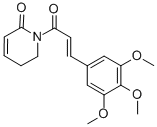
IdentificationPhysical DataSpectraRoute of Synthesis (ROS)Safety and HazardsOther Data
Identification
Product NamePIPERLONGUMINEIUPAC Name1--2,3-dihydropyridin-6-oneMolecular StructureCAS Registry Number 462-08-8EINECS Number20069-09-4MDL NumberMFCD00075706SynonymsPiperlonguminePiplartine20069-09-4UNII-SGD66V4SVJ(E)-1-(3-(3,4,5-trimethoxyphenyl)acryloyl)-5,6-dihydropyridin-2(1H)-oneSGD66V4SVJPPLGMCHEBI:82411--1,2,5,6-tetrahydropyridin-2-one1--2,3-dihydropyridin-6-one2(1H)-Pyridinone, 5,6-dihydro-1-(1-oxo-3-(3,4,5-trimethoxyphenyl)-2-propenyl)-, (E)-2(1H)-Pyridinone, 5,6-dihydro-1--BRD2293BRD-2293(E)-1--5,6-dihydropyridin-2(1H)-onePiplartine;PPLGMPrestwick_399MFCD00075706FERROUSFLUOBORATEST079382Prestwick2_000604Prestwick3_000604Piperlongumine; PiplartinePIPERLONGUMINE 5,6-Dihydro-1--2(1H)-pyridinoneBSPBio_000508PIPERLONGUMINE MLS002153903SCHEMBL173092SPECTRUM1505135BPBio1_000560CHEMBL465843SCHEMBL24655931--5,6-dihydro-1H-pyridin-2-oneACon1_001541CHEBI:92424DTXSID801029762HMS1569J10HMS2096J10HMS2234K24Piperlongumine, >=97% (HPLC)BCP13030EX-A2925HY-N2329BDBM50462013NSC794671s7551AKOS024284776CCG-214375NSC-794671NCGC00096028-01NCGC00096028-02NCGC00096028-03NCGC00096028-04NCGC00096028-14AC-32683AS-74140BP-25401SMR001233252CS-0021113P2361A14124EN300-7424497A920539SR-01000841248A1-00162J-012992N-(3,4,5-Trimethoxycinnamoyl)-D3-piperidin-2-oneQ7197361SR-01000841248-2BRD-K24132293-001-05-3BRD-K24132293-001-09-5BRD-K24132293-001-16-05,6-Dihydro-1-(3,4,5-trimethoxycinnamoyl)-2(1H)-pyridinone1--5,6-dihydro-2(1H)-pyridinone1--5,6-dihydro-2(1H)-pyridinone #1--5,6-dihydropyridin-2(1H)-one5,6-Dihydro-1--2(1H)-pyridinone, 9CI5,6-dihydro-1--2(1H)-pyridinone5,6-Dihydro-1--2(Molecular FormulaC17H19NO5Molecular Weight317.34InChIInChI=1S/C17H19NO5/c1-21-13-10-12(11-14(22-2)17(13)23-3)7-8-16(20)18-9-5-4-6-15(18)19/h4,6-8,10-11H,5,9H2,1-3H3/b8-7+InChI KeyVABYUUZNAVQNPG-BQYQJAHWSA-NIsomeric SMILESCOC1=CC(=CC(=C1OC)OC)/C=C/C(=O)N2CCC=CC2=O
Patent InformationPatent IDTitlePublication DateWO2022/153306ANTI-QUORUM SENSING, ANTI-BIOFILM, AND INFLAMMATION ATTENUATING COMPOUNDS, COMPOSITIONS, AND METHODS OF USING SAME2022WO2020/68425COMPOSITIONS AND METHODS FOR ENHANCING INSULIN SECRETION2020WO2019/54891TRPV2 ANTAGONISTS2019WO2019/103897DERIVATIVES OF PIPERLONGUMINE AND USES THEREOF2019 WO2016/14625COMPOSITIONS AND METHODS FOR SELECTIVELY DEPLETING SENESCENT CELLS2016
Physical Data
AppearanceWhite to off-white powder
Melting Point, °C 120 - 121122 - 123156 - 158125 - 127124
Density, g·cm-31.2
Description (Association (MCS))Solvent (Association (MCS))Temperature (Association (MCS)), °CPartner (Association (MCS))Association with compounddimethyl sulfoxide24.84calf thymus DNA
Spectra
Description (NMR Spectroscopy)Nucleus (NMR Spectroscopy)Solvents (NMR Spectroscopy)Frequency (NMR Spectroscopy), MHzChemical shifts, Spectrum1H400Chemical shifts, Spectrum13C100Chemical shifts1Hchloroform-d1300Chemical shifts13Cchloroform-d175
Description (IR Spectroscopy)Solvent (IR Spectroscopy)Temperature (IR Spectroscopy), °CBands, Spectrum Bands, Spectrumpotassium bromideATR (attenuated total reflectance), Bands
Description (UV/VIS Spectroscopy)Solvent (UV/VIS Spectroscopy)Comment (UV/VIS Spectroscopy)Absorption Maxima (UV/VIS), nmSpectrum230, 330Spectrumaq. phosphate bufferSpectrumSpectrumacetonitrile
Route of Synthesis (ROS)
Route of Synthesis (ROS) of PIPERLONGUMINE CAS 20069-09-4
ConditionsYieldStage #1: glycine ethyl ester hydrochloric acid With triethylamine In ethanol at 20℃; for 0.5h;Stage #2: (E)-1-(3-(3,4,5-trimethoxyphenyl)acryloyl)-5,6-dihydropyridin-2(1H)-one In ethanol at 20℃; for 1.5h;78%Stage #1: glycine ethyl ester hydrochloric acid With triethylamine In ethanol at 20℃; for 0.5h;Stage #2: (E)-1-(3-(3,4,5-trimethoxyphenyl)acryloyl)-5,6-dihydropyridin-2(1H)-one In ethanol for 1.5h;Experimental ProcedureTo a stirred solution of glycine ethyl ester. HC1 (66.04 mg, 0.473 mmol) in ethanol (0.8 mL), triethylamine 48.2 mg, 0.473 mmol) was added and stirred for 30 min. To this SPL (50.0 mg, 0.157 mmol) was added and stirred at room temperature. The reaction was monitored by TLC (Hexane-ethyl acetate (1:1). Starting material consumed within 1.5 h. After completion, the reaction mixture was quenched with 5% aq. HC1 (10 mL) and extracted with ethyl acetate (2 x 20 mL), the combined organic layer was washed with water (1 x 20 mL), 5% NaHCOs solution (20 mL), water (2 x 20 mL), dried over anhyd. Na2SO4 and concentrated under reduced pressure. To the crude reaction mass, 2 mL of diethyl ether was added, and the reaction mass was filtered and dried to get pure product as white solid in 40 mg (yield 78%).78%
Safety and Hazards
Pictogram(s)SignalWarningGHS Hazard StatementsH302 (50%): Harmful if swallowed H315 (100%): Causes skin irritation H319 (100%): Causes serious eye irritation H335 (100%): May cause respiratory irritation Precautionary Statement CodesP261, P264, P264+P265, P270, P271, P280, P301+P317, P302+P352, P304+P340, P305+P351+P338, P319, P321, P330, P332+P317, P337+P317, P362+P364, P403+P233, P405, and P501(The corresponding statement to each P-code can be found at the GHS Classification page.)
Other Data
Shelf Life1 yearMarket Price
DruglikenessLipinski rules componentMolecular Weight317.342logP1.413HBA3HBD0Matching Lipinski Rules4Veber rules componentPolar Surface Area (PSA)65.07Rotatable Bond (RotB)6Matching Veber Rules2
Quantitative Results1 of 264Comment (Pharmacological Data)Bioactivities presentReferenceCYTOTOXIC PYRIDONE ALKALOIDS FROM PIPER ABORESCENS2 of 264Comment (Pharmacological Data)Bioactivities presentReferenceALR2 INHIBITORS AND THEIR SYNTHESIS FROM A NATURAL SOURCE 3 of 264Comment (Pharmacological Data)Bioactivities presentReferenceA piperidine amide extracted from Piper longum L. fruit shows activity against Aedes aegypti mosquito larvae.4 of 264Comment (Pharmacological Data)Bioactivities presentReferencePiperlongumine for Enhancing Oral Bioavailability and Cytotoxicity of Docetaxel in Triple-Negative Breast Cancer5 of 264Comment (Pharmacological Data)Bioactivities presentReferenceMETHOD OF TREATING MEDULLOBLASTOMA6 of 264Comment (Pharmacological Data)Bioactivities presentReferencePiperlongumine induces G2/M phase arrest and apoptosis in cholangiocarcinoma cells through the ROS-JNK-ERK signaling pathway7 of 264Comment (Pharmacological Data)Bioactivities presentReference Fragmentation pattern of amides by EI and HRESI: Study of protonation sites using DFT-3LYP data8 of 264Comment (Pharmacological Data)Bioactivities presentReferenceMild, Metal-Free and Protection-Free Transamidation of N-Acyl-2-piperidones to Amino Acids, Amino Alcohols and Aliphatic Amines and Esterification of N-Acyl-2-piperidones9 of 264Comment (Pharmacological Data)Bioactivities presentReferenceAn autophagy modifier screen identifies small molecules capable of reducing autophagosome accumulation in a model of CLN3-mediated neurodegeneration10 of 264Comment (Pharmacological Data)Bioactivities presentReferenceCOMPOSITIONS AND METHODS FOR TREATING RAS-MUTANT CANCERS
Use Patternpiperlongumine-cas-20069-09-4 has been used in traditional medicine as an analgesic and anti-inflammatory agent, particularly in traditional Chinese medicine. It is believed to have potential benefits for certain conditions and dietary supplement.
https://www.chemwhat.com/piperlongumine-cas-20069-09-4/
Comments
Post a Comment